The need to carry cash could soon become a thing of the past as payment by smartphone gains pace. Andrew Don and Gaelle Walker investigate
As a convenience store retailer operating at the tail end of 2011, you could be about to witness one of the most radical changes to the way in which shoppers pay for goods since the launch of debit cards in the mid-1980s.
Near field communication (NFC)-enabled smartphones that allow shoppers to buy from you with a swipe of their embedded chips will take off in 2013, following on from the accelerated uptake of contactless payment using plastic cards in this past year. This July UK shoppers made 567,000 contactless transactions - a dramatic increase from six months before, when only 200,000 were made. So why now?
Well, as with anything new, a little time is always needed for the foreign to become friendly. And now, nearly four years after the UK’s first contactless payment scheme rolled out across London, shoppers and retailers are starting to realise its benefits.
And there are lots. With no need to enter a PIN or wait for a receipt it’s faster - 500 milliseconds to be exact - and much more convenient. And for security reasons transaction limits are currently fixed at £15, making contactless payments perfect for top-up shops and snack stops at busy convenience stores. With lower transaction fees, contactless is also proving to be an increasingly attractive option for retailers, too.
As a result, the number accepting contactless payment has also soared - up from 26,000 to 69,000 in the year to July 2011. This number is expected to multiply in the spring of 2012 ahead of the Olympics later that year, which will see thousands of tourists flock to our cities and their stores in need of quick food, and service to match. By early 2012, all London buses will be contactless-enabled with the tube and overground network to follow later in the year.
This year the Co-operative Group joined the ranks of UK retailers and food-to-go operators already offering shoppers the chance to swipe and pay, including Subway, Starbucks, McDonald’s and Eat. The latter saw its average transaction value climb by 6% following the launch of contactless-enabled readers in its stores, as shoppers were no longer constrained by the amount of cash in their pockets.
Now, while the vast majority of these payments are currently being made on contactless-enabled plastic cards, smartphones look set to take over as the primary medium.
Smartphones are expected to account for more than 50% of the total mobile market by 2012, with huge growth in NFC-enabled devices predicted in 2013 and 2014. In fact, experts predict that smartphones are likely to render the plastic debit card obsolete within the next decade.
Barclaycard’s senior contactless product manager Craig Priddey is one such believer.
“Next year with the Olympics, consumers will become very used to the mechanics of contactless, and as technology continues to advance, it won’t be long before phones with NFC chips replace plastic, and physical wallets, altogether,” he says.
Last month payment service provider yes-wallet.com made headlines when it launched the UK’s first e-wallet: Pouch. The service, which is available to download as an app, will allow shoppers to use their smartphones as wallets, automatically debiting money from their accounts with a single swipe.
Google is also planning to bring its Google Wallet trial to the UK next year.
So, what do the symbol groups feel about contactless and the mobile medium? Well, it’s fair to say that there have been a few minor glitches. Spar, for example, had planned to achieve the rollout of contactless payment terminals by the end of this September, but it discovered the VeriFone VX 810 terminal it was going to use did not support some of the emerging technologies such as NFC, which is needed for use with smartphones.
As a result, the group took the decision to opt for the next model up, the VX 820, that is expected to be accredited by Royal Bank of Scotland before 2011 is out.
Spar IT controller Roy Ford says the symbol group will then start to roll it out to its retailers in the first quarter of 2012.
Spar has seven contactless card pilots in central London that are integrated into existing epos as well as using standalone terminals. Processing rates for these retailers are about 40% cheaper for transactions between £2.01 and £10, while for transactions less than £2.01 it’s about 70% cheaper because the banks are happy to give a much lower transaction rate to encourage retailers to accept contactless payment.
Processing rates for payments of more than £10 have not been made cheaper, but Spar doesn’t think that will be a problem because average debit card payment is estimated to be about £8 through its independent retailers.
According to Ford, terminals cost an extra £3 each per month rental than for non-contactless types, but the reduction in transaction costs should prove attractive.
“There is no doubt we want to do it. We just don’t want to roll out a system that uses today’s technology and not tomorrow’s. Mobile phone payments will be as important as anything else,” he adds.
And retailers are clearly keen. “When Chip and PIN came out we were telling retailers all the time what was going to happen and when, but we are finding now that a lot more retailers are asking us about contactless,” says Ford. “There’s an enthusiasm, but I still feel I was right to hold out for NFC because today’s youth love their mobile phones and if they can use them to make payments, it’s an area of business we would like to have.”
Costcutter, too, is waiting for the VeriFone VX 820 to be accredited. While national epos manager Mark Leary says Costcutter retailers will accept contactless cards, he is adopting a wait-and-see approach to NFC-enabled smartphones. “Most of our retailers are franchisees so it is up to them to buy the terminal themselves,” he says. He adds that all new installations from mid-October onwards are expected to be with the VX 820 terminals.
And he says if payment by smartphone takes off, Costcutter will be on board.
Nisa is implementing Yes Pay, its new electronic fund transfer (EFT) provider, which will allow it to incorporate contactless payment for all future installations and allow any existing user of Nisa’s Epositive system to have this functionality if they choose.
Epositive sales manager Dave MacKay says Yes Pay ensured retailers were future-proofed without the need to amend the point of sale equipment so they would be able to accept all forms of contactless payment.
All new Epositive members were expected to have this technology as part of the standard kit from the end of October. “As for our existing members, we would hope they would see the benefits of the new technology along with our improved EFT cost with Yes Pay and be fully compliant by March 2013.”
Like Priddey, MacKay believes that payment by smartphone will be commonplace in the next three years, with uptake more prominent in cities where customers want to be in and out of stores as quickly as possible. “Rural areas will follow suit towards the end of the next three years,” he says.
Nisa has found younger retailers are excited by the new technology and view it as a huge benefit to themselves and their customers.
However, some retailers, such as Devshi Khunti, of Thorrington Store, in Essex, will clearly take more convincing. “I don’t see any advantage,” he says, adding that his rural location would likely result in low demand.
The older generation of retailer is also reluctant. These stalwarts of the trade are fearful of the technology’s impact on customer service. After all, isn’t the independent retailer’s ability to season every transaction with a peppering of personal touch the industry’s strongest point of difference against the multiples? Surely this is more important than the speed of a transaction?
Well, MacKay’s not so sure. “A customer coming into your store now views two people waiting to be served as a queue, and with people having less and less time they are more likely to leave the store rather than wait in a queue, thus causing a negative experience at the store which may harm future sales,” he says. And, after all, just offering service with a swipe doesn’t mean you can’t throw in a smile.
One independent early adopter is Seddlescombe Post Office in East Sussex, which is a Premier store. Store owner John Mainwood’s son Jeff, 20, encouraged him to take it on, using the existing terminal from Barclays Merchant Services. “It’s not widely used at the moment, but we have facilities for it. We get one or two transactions a month. We are a village with older people so not really the sort of area where you will get younger people hot on new technology.”
But Mainwood believes it has potential and will be used more frequently in the future, although this could take a couple of years.
Many scare stories have been spread about security risks such as theft of cards and mobile devices, and transactions intercepted by passers-by with technology that enables them to do so. But Mark Carpenter, solutions marketing manager at card processing and electronic fund transfer specialist The Logic Group, which works with Musgrave, says stores and customers can be sure they have the same level of protection as Chip and PIN transactions.
However, he says: “Fear of the unknown, when combined with a lack of understanding, is a barrier that we need to overcome.”
Banks will continue to take responsibility for any fraud committed as long as the retailer is clearly not at fault. Carpenter says the acquirer sets the number of transactions that can be made before the PIN is required, helping to manage the risk, and PINs have to be entered for all transactions of more than £15.
Others say, depending on the agreement that’s been struck with the retailer, that PINs will have to be inputted after a set number of transactions - Ford says about 10 in Spar’s case and Leary says four in Costcutter’s case.
Leary adds: “If banks are taking liability, people are probably going to be more concerned about card skimming and other things like cash machine tampering.”
Nisa’s MacKay has no security concerns to date, having fully tested all hardware and software.
So whether you like it or not, contactless payment, and its smartphone facilitator, looks set to not only stay, but revolutionise the way you do business in the very near future.
However, given the speed with which the technology is expected to advance, smartphones probably won’t remain the primary medium for long. Trials with embedded NFC-enabled chips in watches and wristbands are already under way, and the idea of manufacturing sticky-backed chips that could be bought and stuck to a whole host of other products are also being explored. “People could stick them on their foreheads if they really wanted to,” jests Barclaycard’s Priddey. Now that really would bring a whole new meaning to the term customer facing!
Whu go contactless?
● Increased footfall
● Improved customer experience
● Faster transactions
● Cheaper processing
● Shorter queues
● Less lost sales due to abandonment of goods at checkout
● Appeals to a new generation of technology-savvy customers
● NFC-enabled smartphones can be linked with discounts, coupons and loyalty schemes
● Reduced operating and cash-handling costs. s a convenience store retailer operating at the tail end of 2011, you could be about to witness one of the most radical changes to the way in which shoppers pay for goods since the launch of debit cards in the mid-1980s.
















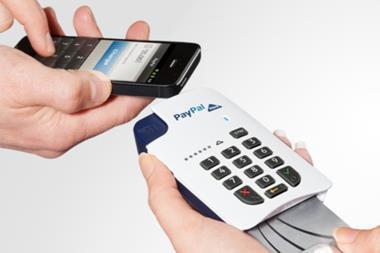
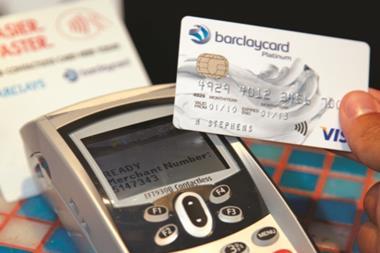
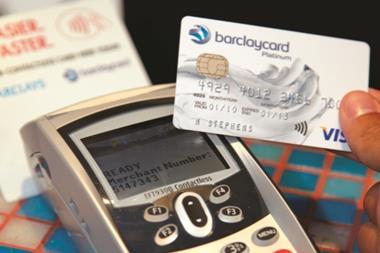

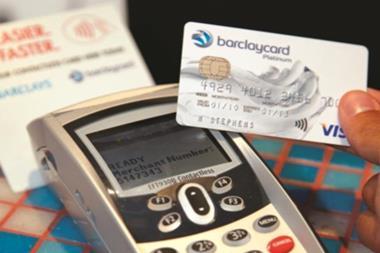





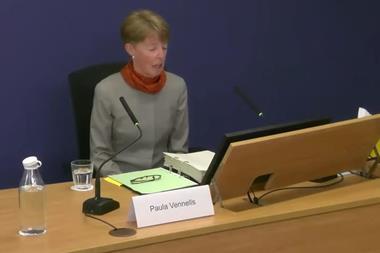

1 Readers' comment